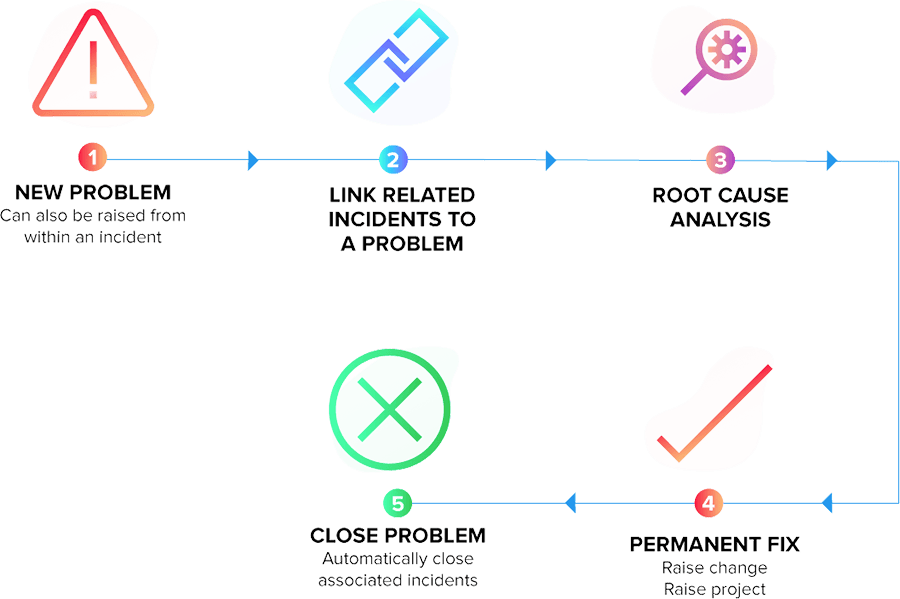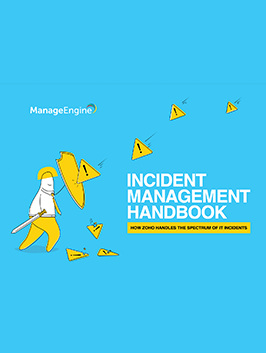- What is IT problem management?
- Incident management vs. problem management
- Reactive problem management vs. proactive problem management
- What are the benefits of IT problem management?
- IT Problem management roles and responsibilities
- IT Problem management process flow
- The relationship between the ITSM processes and problem management
- IT Problem management techniques
- IT Problem management best practices
- IT Problem management key performance indicators
- The best features for problem management software
- Conclusion
The Comprehensive Guide to IT Problem Management is a six-part series that aims to help readers understand the multiple facets of problem management in an IT environment.
This guide delves into the various approaches of problem management, as well as the processes behind them, and provides practical examples to help you properly prepare for your problem management journey.
What is IT problem management?

A problem is the cause or potential cause of multiple incidents. Problems can arise from major incidents affecting many users, or from recurring incidents. Further, problems can be identified in infrastructure diagnostic systems before users are affected.
Incidents hinder business productivity, and providing quick solutions helps ensure seamless continuity of business operations. However, when multiple incidents occur at once or the same incident occurs multiple times, it's not feasible to move forward by providing patchwork solutions, or offering the same resolutions over and over again.
IT problem management is a procedural way to ensure minimal incidents emerge from IT infrastructure operations by delving deep into incidents to find the root causes and fixes, and also reduce the severity of the incidents through suitable documentation of existing issues and providing workarounds.
Problem management is a methodical approach to identify the cause of an incident and manage the life cycle of all problems. The goal of IT problem management process is to minimize the impact of incidents and eliminate recurring ones. While there are no hard and fast rules to perform problem management, here are three common phases you can follow in your approach:
-

Problem identification
-

Problem control
-

Error control
These phases will be discussed in detail later in the guide.
Reactive management deals with incidents that are currently affecting users, whereas proactive problem management addresses issues that could potentially surface as incidents in the future should they be left alone.
A sound problem management process has the potential to significantly reduce the influx of incident tickets, saving IT service desk staff significant time and effort. This advantage ripples into other benefits such as reduction in mean time to repair (MTTR), higher customer satisfaction, a robust known error database, and reduced cost of IT services and issues. Moreover, an organization that practices proactive problem management is likely to find tremendous value from identifying and eliminating issues before they disrupt business processes.
Problem management as an ITSM practice is most useful when used with other ITSM practices in the overall service value chain. Information is exchanged between the various ITSM practices, namely incident management, change management, IT asset management, knowledge management, and continual service improvement. This information exchanged between parties accumulates value as it moves through each ITSM practice, in turn building an ideal ITSM engine in your enterprise.
Before going further, the following definitions will be useful in understanding the context of this guide.
- Workaround: Temporary solutions that restore services and ensure business continuity. A workaround reduces the impact of an incident or problem.
- Root cause analysis (RCA): The root cause is the problem's underlying issue. RCA is the investigation techniques that help discover the root cause of a problem.
- Known error: Problems that have occurred before and have a workaround or known root causes.
- Known error database (KEDB): A database created by documenting the known errors using incident management and problem management.
In this guide, we'll examine each facet of problem management in detail, providing all the knowledge you need to get up to speed on how to implement problem management in your enterprise.
What are the benefits of IT problem management?

There are a few hurdles organizations might encounter in the process of establishing problem management. The organization might not have the resources to allocate for a problem management team, or it may already have an unorthodox way of managing problems and is reluctant to change. Sometimes, it could just be a cost-related denial of request.
Consequently, it's vital to include all stakeholders in the problem management process, and express how it provides value to different facets of the organization. These benefits include:
- Eliminates the faults in an organization's services through suitable documentation.
- Refines the service design by identifying and solving weak points, ensuring the most effective and efficient path for service delivery.
- Increases the first time fix rate on service failures by providing permanent solutions to incidents rather than stopping at workarounds.
- Diminishes the impact of incidents affecting multiple users, or a single user at a crucial time.
- Prevents most of the incidents and problems plaguing an organization over time, boosting user productivity.
- Strengthens the confidence users have in the organization's IT services.
- Decreases the time it takes to recover from failures through systematic maintenance of a KEDB.
- Prevents recurring incidents through one-time fixes, sparing valuable service desk efforts in resolving them.
- Encourages IT services to mature as the organization develops by the learning from the resolved problems.
- Develops IT talent within the organization through technical awareness and valuable insights.
Take the first step in your problem management journey
IT Problem management roles and responsibilities

The roles of a problem management team are directly related to the organizational structure that is present. The organization's age, culture, technology, and number of locations worldwide affect the composition of its problem management team. In the case of small IT organizations, the team's responsibilities might all be combined, or in the case of large, multinational corporations, they may be specialized.
Either way, it's up to the convenience and flexibility of the IT team to tailor an arrangement that ensures problems are efficiently addressed in alignment with industry-standard best practices. Being aware of the organization's general strategy is a good starting point to initiate the team formation. Also, it's important to be wary of the resources the organization is ready to expel for the development of a problem management team.
The team's roles and responsibilities should extend, diverge, and mature as the organization's technology grows, otherwise confusions in accountability can arise during service delivery.
The general roles and responsibilities of problem management teams are listed below.
| Role | Responsibility |
|---|---|
| Problem manager | Responsible for the effectiveness and efficiency of the entire practice. Akin to team leader. |
| Problem owner | Accountable for the life cycle of any problem tickets they're assigned. |
| Problem agent | Accountable for the tasks associated within a problem ticket. |
| Diagnosis team | An assortment of people with various expertise, responsible for RCA of a problem. |
IT Problem management process flow
Just like an organization creates value for its customers, IT service management creates value for its users through best practices, and indirectly aids in creating value for the organization. To create this value, there must be a process with defined inputs and outputs. When an effective service desk is put in place, the streamlined flow of a problem process looks like this:

You can implement problem management processes with any technology you deem the right fit for your organization. The technology put in place should have functionalities that enable the three phases of IT problem management.
The three phases are:


Problem identification
The problem identification phase identifies and records problems in a management tool. A service desk tool associated with multiple practices of service management, including incident management, asset management, the CMDB, and change management, gives organizations an advantage in this phase.
While the service desk staff would normally report problems based on a surge of incidents, a proactive approach to problem management identifies problems by:
- Analyzing incident trends, leveraging network monitoring systems, and utilizing other diagnostic software.
- Detecting risks from incidents that might recur.
- Evaluating information received from partners and suppliers.
- Evaluating information from internal software developers, engineers, and test teams.
Depending on your organization's structure, domain, and culture, there could be even more modes through which problems can be identified. Nevertheless, it's important to have a system in place for problems to be brought in, identified, prioritized, and recorded for further investigation and diagnosis.

Problem control
Problem management is a collaborative effort, so for results to be effective, multiple departments and stakeholders should be involved in the problem control phase.
Problem control includes activities like prioritization, investigation, analysis, and documenting known errors and workarounds. There are numerous techniques that help in prioritization and analysis of problems. A good rule of thumb to follow is first tackling problems that, when solved, significantly curb the disruption of services in the organization.
Feasibility is another aspect to note when tackling problems. Fixing a problem permanently might require more resources than settling for a workaround. A quick cost-benefit analysis can determine whether you should proceed with a permanent fix or not.
Workarounds are documented in problem records. Generally, if a problem persists longer, implementing a quick workaround is advisable. This workaround can even be a part of incident management resolution; however, the problem management team should review the workaround and refine the resolution if necessary. As you can see, an effective incident workaround can become a permanent solution to some problems.

Error control
This phase manages known errors from the KEDB by regularly checking it for possible permanent fixes if they pass the cost-benefit analysis.
Once a problem is analyzed, it's documented as a known error. These known errors are regularly reassessed to account for the impact they create, and to test the effectiveness of workarounds.
Up next:
Now with a clear understanding of problem management’s role in an IT environment, we will next compare and contrast problem management with its supporting ITSM practices.
Assess your incident response readiness to kick-start your problem management journey
The zeroth step in the journey towards proactive problem management is establishing a robust incident management process in your IT environment. Discover how Zoho, our parent company, handles the spectrum of incidents thrown at it year over year and assess your incident management readiness at an enterprise scale.
Download a free copy of our incident management handbook and a best practice checklist to review your problem management solution.
-

Problem management feature checklist
-

IT incident management handbook
Frequently asked questions:
1. What is an example of problem management?
2. What are the 3 phases of problem management?
Problem management in ITSM typically follows a three-phase approach:
- Problem detection and identification: This phase involves recognizing recurring incidents and identifying them as a potential underlying problem. This can involve analyzing trends in incident reports, user feedback, or proactive monitoring tools.
- Investigation and diagnosis: Once a problem is identified, the team delves deeper to understand its root cause. This might involve analyzing logs, replicating the issue, or consulting technical expertise.
- Resolution and closure: The final phase focuses on implementing a permanent fix to address the root cause. This could involve developing a workaround, applying a software patch, or recommending hardware upgrades. The problem record is then closed once the fix is verified and the issue is no longer recurring.
3. What is the role of a problem manager in IT?
The role of a problem manager in IT involves ensuring the long-term stability and efficiency of IT services by identifying and addressing the root causes of recurring incidents. This is accomplished through the analysis of data, thorough the investigation of issues, and close collaboration with technical teams to implement permanent solutions.

